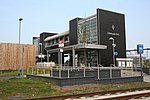Hermiston, Edinburgh
Areas of EdinburghEdinburgh geography stubsUse British English from January 2018

Hermiston is a hamlet formerly in the County of Midlothian and now part of Edinburgh, the capital of Scotland. It is north of the Heriot-Watt University Riccarton Campus and west of the Hermiston Quay commercial development. Hermiston is bounded by the A71 Calder Road to the south and the Union Canal to the north with the M8 motorway just beyond. The hamlet forms the Hermiston Conservation Area. Hermiston is also notable as the setting of the Robert Louis Stevenson novel, Weir of Hermiston. The city of Hermiston, Oregon in turn takes its name from the book.
Excerpt from the Wikipedia article Hermiston, Edinburgh (License: CC BY-SA 3.0, Authors, Images).Hermiston, Edinburgh
City of Edinburgh Currie
Geographical coordinates (GPS) Address Nearby Places Show on map
Geographical coordinates (GPS)
| Latitude | Longitude |
|---|---|
| N 55.917777777778 ° | E -3.3133333333333 ° |
Address
EH14 4AT City of Edinburgh, Currie
Scotland, United Kingdom
Open on Google Maps





